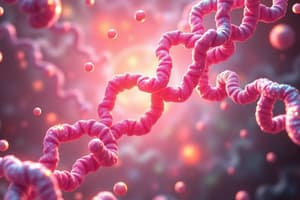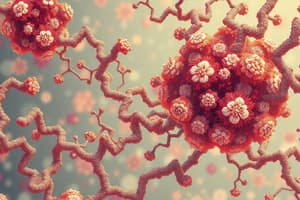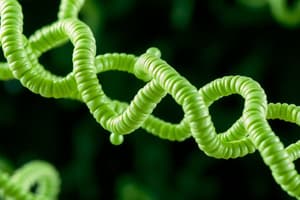Podcast
Questions and Answers
Proline has a secondary amino group and forms a rigid ______ membered ring.
Proline has a secondary amino group and forms a rigid ______ membered ring.
5
The hydroxyl group of serine and threonine serves as a site of attachment for ______ groups in proteins.
The hydroxyl group of serine and threonine serves as a site of attachment for ______ groups in proteins.
phosphate
Disulfide bonds are formed when the -SH groups of two ______ become oxidized.
Disulfide bonds are formed when the -SH groups of two ______ become oxidized.
cysteines
Amino acids with acidic side chains act as proton ______ and are negatively charged at physiological pH.
Amino acids with acidic side chains act as proton ______ and are negatively charged at physiological pH.
Amino acids with basic side chains act as proton ______ and are positively charged at physiological pH.
Amino acids with basic side chains act as proton ______ and are positively charged at physiological pH.
Amino acids with basic side chains are considered to be a ______ base.
Amino acids with basic side chains are considered to be a ______ base.
The α-carbon of amino acids is ______ or optically active.
The α-carbon of amino acids is ______ or optically active.
Amino acids in mammals predominantly exist in the ______ form.
Amino acids in mammals predominantly exist in the ______ form.
Amino acids contain weakly acidic α-______ groups.
Amino acids contain weakly acidic α-______ groups.
Buffers are weak acids or bases that can resist small changes in ______.
Buffers are weak acids or bases that can resist small changes in ______.
The Henderson-Hasselbalch equation relates pH to the concentration of ______ and its conjugate base.
The Henderson-Hasselbalch equation relates pH to the concentration of ______ and its conjugate base.
Maximum buffering capacity occurs at pH equal to Ka plus or minus ______ unit.
Maximum buffering capacity occurs at pH equal to Ka plus or minus ______ unit.
Amino acids have a pK value for every dissociable ______.
Amino acids have a pK value for every dissociable ______.
The dissociation constant for the carboxyl group is referred to as ______.
The dissociation constant for the carboxyl group is referred to as ______.
At the pK1 value, half of the carboxyl groups in solution are ______.
At the pK1 value, half of the carboxyl groups in solution are ______.
Proteins are the most abundant molecules in living ______
Proteins are the most abundant molecules in living ______
Enzymes act as biological ______, increasing reaction rates.
Enzymes act as biological ______, increasing reaction rates.
In muscles, ______ proteins allow for movement.
In muscles, ______ proteins allow for movement.
The carbon atom in amino acids is referred to as the ______-carbon.
The carbon atom in amino acids is referred to as the ______-carbon.
At physiological pH, the carboxyl group forms a negatively charged ______ ion.
At physiological pH, the carboxyl group forms a negatively charged ______ ion.
Amino acids can be classified based on the properties of their ______ chain.
Amino acids can be classified based on the properties of their ______ chain.
Amino acids with non-polar side chains do not participate in ______ or ionic bonds.
Amino acids with non-polar side chains do not participate in ______ or ionic bonds.
The amino group of amino acids is usually protonated as ______+ at cellular pH.
The amino group of amino acids is usually protonated as ______+ at cellular pH.
Buffer pairs -COOH/COO- is a buffer pair in the acid pH range and -NH3+/-NH2 pair buffers in the ______ pH range.
Buffer pairs -COOH/COO- is a buffer pair in the acid pH range and -NH3+/-NH2 pair buffers in the ______ pH range.
If pH = pK1, then equal amounts of forms I and II are ______.
If pH = pK1, then equal amounts of forms I and II are ______.
The isoelectric point (pI) is the pH at which form II is predominant, with equal amounts of forms I and ______.
The isoelectric point (pI) is the pH at which form II is predominant, with equal amounts of forms I and ______.
Most amino acids have a net charge of zero at ______ pH.
Most amino acids have a net charge of zero at ______ pH.
Amino acids are known as ______ ions as they carry both a positive and negative charge.
Amino acids are known as ______ ions as they carry both a positive and negative charge.
The bicarbonate buffer system can be represented by the equation CO2 + H2O H2CO3 H+ + ______.
The bicarbonate buffer system can be represented by the equation CO2 + H2O H2CO3 H+ + ______.
Drugs pass through membranes readily in their ______ form.
Drugs pass through membranes readily in their ______ form.
Effective concentration of a drug at the absorption site depends on the concentration of the ______ and undissociated forms.
Effective concentration of a drug at the absorption site depends on the concentration of the ______ and undissociated forms.
Flashcards are hidden until you start studying
Study Notes
Protein Function
- Most abundant molecule in living systems.
- Responsible for various vital functions such as:
- Catalysis of biochemical reactions as enzymes.
- Regulation of metabolism through polypeptide hormones.
- Facilitating movement through contractile proteins in muscles.
- Providing structural support with collagen in bone.
- Transport and storage of molecules, like hemoglobin and myoglobin for oxygen, and plasma albumin for fatty acids.
- Immune defense with immunoglobulins.
Structure of Amino Acids
- All amino acids contain:
- A primary amino group (-NH2).
- A carboxyl group (-COOH).
- A hydrogen atom.
- A distinctive side chain (R group) bonded to a central carbon atom, also known as the α-carbon.
- The structure of the R group differentiates each amino acid.
Properties of Amino Acids
- At physiological pH (~ 7.4):
- The carboxyl group is dissociated forming the negatively charged carboxylate ion (COO-).
- The amino group is protonated (NH3+).
- Under normal cellular conditions (~ pH 7.4), amino acids are zwitter ions (dipolar ions) due to:
- Carboxyl group: COO-.
- Amino group: NH3+.
- In proteins, the carboxyl group of one amino acid is bound to the amino group of the adjacent amino acid in the peptide linkage.
- The carboxyl and amino groups of amino acids are usually not involved in chemical reactions except for hydrogen bond formation.
Classification of Amino Acids
- Chemical properties and function derive from the side chain (R group).
- Amino acids are classified based on the properties of their R groups:
- Non-polar side chains (9): These side chains do not bind or release protons and do not participate in hydrogen or ionic bonds. They are further categorized as aliphatic or aromatic.
- Uncharged polar side chains (6): These side chains have a zero net charge at neutral pH. They participate in hydrogen bond formation. They also serve as attachment sites for phosphate groups (serine, threonine) and oligosaccharides (serine, threonine, asparagine) in proteins.
- Cysteine's sulfhydryl (-SH) group can lose a proton at alkaline pH and form disulfide bonds (-S-S-) in the oxidized form.
- Acidic side chains (2): These side chains are fully ionized and negatively charged at physiological pH, acting as proton donors.
- Basic side chains (3): Side chains are fully protonated and positively charged at physiological pH, functioning as proton acceptors.
Non-Polar Amino Acids
- Side chains tend to cluster together within the interior of the protein due to their hydrophobicity.
- In membrane proteins, nonpolar groups are on the outside surface of the protein to interact with the non-polar lipid membrane.
- Proline has a unique cyclic structure with a secondary amino group due to its side chain forming a 5-membered ring, playing a crucial role in collagen structure.
Optical Properties of Amino Acids
- The α-carbon of an amino acid is chiral or optically active, with the exception of glycine.
- This chirality results in D-forms and L-forms (stereoisomers, optical isomers, enantiomers).
- Mammals primarily utilize the L-form of amino acids.
Acid-Base Properties of Amino Acids
- Amino acids contain weakly acidic α-carboxyl groups and weakly basic α-amino groups.
- Acidic and basic amino acids contain ionizable groups within the side chain.
- Amino acids serve as buffers by resisting small changes in pH.
Henderson-Hasselbalch Equation
- Relates pH, pKa, and the ratio of a weak acid (HA) and its conjugate base (A-) in a buffer solution.
- Equation: pH = pKa + log([A-]/[HA]).
Titration of Amino Acids
- Amino acids have a pK value for every dissociable group.
- Alanine: titrated with NaOH, shows two pK values:
- pK1 (2.3) representing the dissociation of the carboxyl group.
- pK2 (9.7) representing the dissociation of the amino group.
- Isoelectric point (pI) is the pH at which the molecule has a net charge of zero.
- For alanine, pI is the average of pK1 and pK2.
Buffers in Amino Acid Titration
- Buffer pairs:
- -COOH/COO- pair buffers in the acid pH range.
- NH3+/-NH2 pair buffers in the basic pH range.
- pH = pK: if pH = pK1, equal amounts of forms I and II are present.
- Isoelectric point (pI):
- The pH where form II predominates with equal amounts of forms I and III.
- The average of pK1 and pK2.
Amino Acid Zwitterions
- Most amino acids have a net charge of zero at physiological pH due to the negatively charged α- carboxyl (–COO-) and positively charged α – amino (-NH3+).
- Isoelectric point (pI): pH at which the molecule has a net charge of zero.
- Amino acids are called zwitter ions (carry both a positive and negative charge) and are amphoteric.
Bicarbonate Buffer System
- CO2 + H2O H2CO3 H+ + HCO3-.
- Equation: pH = pK + log([HCO3-]/[H2CO3]).
- Regulates blood pH.
- Respiratory acidosis: increase in CO2 leads to increase in H2CO3 and decrease in pH.
- Increase in bicarbonate concentration increases pH.
Effect of pH on Drug Absorption
- Drugs readily pass through membranes in their uncharged form.
- Weak acids and weak bases:
- Weak acid (HA) ↔ H+ + A-.
- Weak base (BH+) ↔ B + H+.
- Effective concentration depends on the concentration of the dissociated and undissociated forms.
- Factors influencing the concentration of the dissociated and undissociated forms:
- pH at the absorption site.
- pKa of the ionizable group.
- Aspirin: weak acid, permeates in the HA (undissociated) form.
- Morphine: weak base, permeates membrane in its B (dissociated) form.
Studying That Suits You
Use AI to generate personalized quizzes and flashcards to suit your learning preferences.




